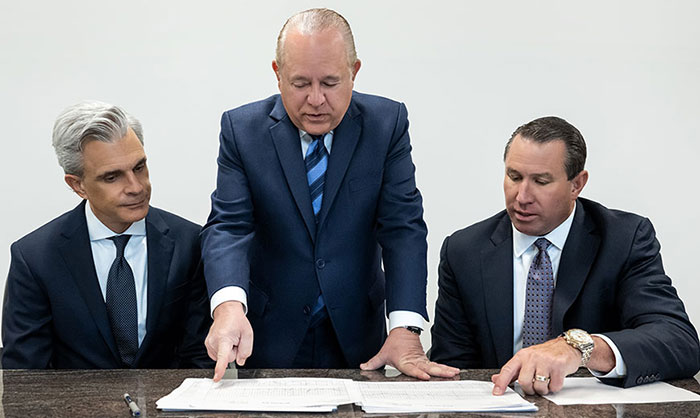What Is the Difference
Between Birth Defect And Birth Injury?
A number of factors separate a birth defect from a birth injury. Although many parents may mistake one for another, it’s critically important to recognize the subtle differences between birth defects and birth injuries in order to provide the correct treatment to your child and understand you and your child’s legal rights.

Birth Defects
Birth defects usually develop during the early stages of the pregnancy, typically in the first trimester. Sometimes the cause of a birth defect may be unknown, while in other cases, genetics, maternal health, advanced maternal age, medications, smoking, alcohol or drug use may be contributing factors. Birth defects are often present at birth, and in many cases they may be detected during the pregnancy with the routine ultrasound exams.

Birth Injuries
Birth injuries, on the other hand, usually occur before, during, or just after labor and delivery. During the birthing process, the baby may be deprived of oxygen due to a variety of factors, which can cause hypoxic-ischemic encephalopathy (HIE). HIE may lead to irreversible brain damage for the baby, resulting in cerebral palsy. Medical negligence is involved in many cases of birth injury. With careful fetal monitoring, timely diagnosis and proper treatment, most birth injuries can be prevented.
What are Common Types of Birth Defects?
Some of the common birth defects include:
- Congenital heart defects
- Down Syndrome (genetic disorder where the baby is born with an extra chromosome)
- Cleft palate and cleft lip (malformation of the mouth or lip)
- Eye defects (microphthalmia or anophthalmia)
- Ear defects (microtia or anotia)
- Muscular dystrophy (muscle weakness due to genetic disorders)
- Microcephaly (abnormally small sized head)
- Diaphragmatic hernia (hole in the baby’s diaphragm)
- Hemophilia (defects in blood clotting)
- Esophageal atresia (esophagus defects)
- Spina bifida (malformation of the spine and spinal cord)
- Craniosynostosis (skull defects)
- Gastroschisis (abdominal wall and intestinal defects)

Birth Defects and Medical Negligence
According to the CDC, birth defects usually develop during the first trimester when the baby’s organ formation begins. Unknown causes, genetic factors, environmental factors or a combination of these may cause birth defects. In some cases, the line between birth defects and birth injuries gets blurred if the birth defect was medically preventable or occurred due to medical negligence. Sometimes, a birth injury may appear to be a birth defect that can later be ruled out by comprehensive screening and prenatal testing.
For example, if a doctor is aware their patient is pregnant, but prescribes a medication that is unsafe for expectant mothers, it can lead to a birth defect. In this case, the birth defect may be considered as a birth injury that occurred due to medical negligence and the responsible parties may be held liable for medical malpractice.
Similarly, a medical provider’s failure to diagnose a birth defect in a timely manner, and the resulting delay in treatment, which complicates the baby’s condition further, may constitute medical negligence. Lack of treatment, improper treatment, or a failure to inform the parents about a birth defect promptly (to help them consider termination of pregnancy) may also constitute medical negligence.
Birth Injuries Occurring due to Brain Damage

When a baby’s health condition develops during pregnancy, labor or delivery where genetic factors are not involved, it could be a preventable birth injury caused by medical negligence. Hypoxic-ischemic encephalopathy (HIE), which may eventually result in cerebral palsy, is a prime example of a birth injury that most commonly occurs due to medical negligence.
Failure to detect fetal hypoxia, for instance, or a delay in performing an emergency cesarean section when it was required may lead to severe HIE and cerebral palsy. Let us look at the primary types of brain damage in babies that can cause serious birth injuries when the medical team fails to apply the prevailing standard of care as they should.
Hypoxic-Ischemic Encephalopathy (HIE)
HIE is classified as damage to the brain tissue caused by prolonged and severe oxygen deprivation to the baby’s brain. HIE results in destruction of the brain cells in the cerebral cortex, leading to cerebral palsy or in extreme cases, the death of the baby.
Periventricular Leukomalacia (PVL)
PVL occurs when the blood flow around the brain ventricles (the communicating network with cerebrospinal fluid) is disrupted, resulting in white matter damage. Maternal infection and placental abruption may cause PVL.
Intracranial Hemorrhage
Commonly known as brain bleeding, this condition usually occurs in premature babies. Undetected or improperly treated maternal high blood pressure, infections such as Group B Strep, and placental complications may cause intracranial hemorrhage.
Cerebral Dysgenesis
Cerebral dysgensis is described as abnormal fetal brain formation. It usually occurs because of maternal infections, but may also result from direct trauma to the baby’s head during the birthing process. It may lead to motor dysfunction and lifelong disability.
Types of Birth Injuries

Cerebral Palsy
Cerebral Palsy is a group of neurological disorders resulting from brain damage caused by hypoxic-ischemic encephalopathy (HIE). Cerebral palsy is the most commonly occurring movement and motor disability of childhood.
Erb’s Palsy
Erb’s palsy commonly occurs in babies who suffer from a nerve injury to the shoulder (shoulder dystocia) during delivery. This injury may be caused due to medical negligence when the brachial plexus nerves are severely stretched or torn during the delivery process.
Kernicterus
Kernicterus is a rare form of preventable brain damage that may occur when jaundice in a newborn is improperly treated or left untreated. Excess levels of bilirubin in the blood may cause toxicity in the brain tissue or the central nervous system.
Spinal Cord Injury
A spinal cord injury may occur at the time of birth when the baby suffers trauma due to improper use of vacuum extractors or forceps by the medical provider. Improper use of these tools can strain the baby’s neck while removing the baby from the birth canal, causing spinal cord injury.
Assisted Delivery Device Injury
About five percent of all births involve the use of vacuum extractors or other assisted delivery devices. If the medical provider fails to use the device safely, the baby may suffer from skull fracture, scalp wounds, Erb’s palsy, intracranial hemorrhage, or cerebral palsy.
Can Medical Malpractice Cause A Birth Injury?
Birth injuries may occur because of a number of conditions and risk factors during childbirth. Medical advancements, such as medications, surgery, hypothermia therapy, ultrasound exams, continuous fetal heart rate monitoring, and assessment of physical signs and symptoms and maternal medical history have made it possible to prevent or reduce birth injuries in many cases.
But when obstetricians, nurses or mid-wives delay in diagnosing or misdiagnose a birth injury causing condition a medical malpractice suit is often the only means of justice for the child and their family.
Other common examples of medical negligence that can cause birth injuries include medication errors, wrong treatment, lack of treatment, surgical negligence, or a failure to perform an emergency c-section when necessary.
When the expectant mother develops an infection, high blood pressure or gestational diabetes the risks of birth injury increases. When doctors fail to properly treat these conditions or take into account how they can affect the baby, medical malpractice is often the cause.
Is Your Child’s Birth Injury the Result of Medical Malpractice?
Parents whose children suffer from birth injuries or birth complications want and deserve answers as to cause of their child’s injury and whether mistakes by the doctors and nurses contributed to the injury.
- Were there signs of a birth injury during the pregnancy, labor, and delivery process, or presence of risk factors, which were either not recognized or properly treated?
- Did the medical team fail to order a series of tests to diagnose a suspected birth complication in a timely manner?
- Was the decision to perform a cesarean delivery delayed?
- During the labor and delivery, were there clear indications that their baby was suffering from fetal distress, but appropriate actions were not taken by the obstetrician or nurses?
- Did the neonatal resuscitation team delay in providing important breathing support after birth?
- Were serious neonatal conditions like hypoglycemia or jaundice missed or treated incorrectly?
- Should brain cooling (also called “hypothermia therapy”) have been offered to your baby, but the doctors and nurses failed to perform the appropriate tests or ignored the results of the tests?
The experienced birth injury lawyers at Miller Weisbrod Olesky, who have been through the legal battlefields before, will help you determine if mistakes of the medical providers caused a birth injury to your child, including Hypoxic-Ischemic Encephalopathy (HIE) or cerebral palsy. Our profound and proven birth injury attorneys have represented families all over the United States in their time of need after a birth injury. We use our experience and expertise to obtain you and your child a medical malpractice settlement that will help provide specialized medical therapy in order to maximize the quality of life and independence of your child throughout their life.
Sometimes families are reluctant to contact a medical malpractice lawyer. It’s also not uncommon for parents to feel overwhelmed by the responsibilities they encounter in caring for their injured child and worried that they will not be able to help out in a lawsuit involving their child’s birth injury. Our birth injury attorneys and nursing staff will address these hesitations and concerns, so you can focus on your child and maximizing their care.
Registered Nurses and Nurse-Attorneys Are a Vital Part of Our Birth Injury Team…and Yours

Most birth injury law firms will employ one or two nurses to assist the review of cases and medical research. But Miller Weisbrod Olesky offers an unmatched number of nurses and nurse-attorney employees support to both the birth injury attorneys and our clients.
Our team of registered nursing staff and nurse-attorneys bring a deep level of medical and personal insight to every client’s case. Our nursing team includes both an experienced labor and delivery nurse as well as an ICU nurse. Working closely with the rest of the team, they investigate the reasons behind a birth injury and how medical professionals breached their standard of care.
Meet our Legal Nursing Team
Linda Chalk

As a registered nurse, Linda practiced ICU nursing for 44 years while caring for a wide range of patient conditions. She has worked closely with founding partner Les Weisbrod for over 30 years, investigating and pursuing birth injury cases.
Along with DJ Weisbrod, Linda heads up the firm’s birth injury intake, screening, and medical literature research team. She personally screens all potential cases to ensure that medical issues have been addressed before we file lawsuits on behalf of birth-injured children and their families.
DJ Weisbrod

Before joining Miller Weisbrod, DJ practiced as a surgical nurse in various hospital and operative settings. She has been with the firm over 30 years.
DJ directs Miller Weisbrod’s birth injury intake and medical screening team. She has also served as firm founder Les Weisbrod’s trial nurse for all cases involving medical negligence and birth injury.
Linda Cuaderes

Linda Cuaderes is both a registered nurse and a licensed lawyer. Linda works exclusively in Miller Weisbrod’s Birth Injury and Medical Malpractice section. Linda acts as the firm’s patient advocate and liaison with our young clients and their parents.
Linda combines her legal and nursing experience along with her exceptional organizational talent and attention to detail to make sure each child we represent is provided the highest level of medical care and attendant care during the pendency of their case. Linda communicates with our parent clients regularly to monitor their birth injured child’s treatment, provide guidance as to additional care and therapies and when necessary assist them in obtaining specialized medical providers.
Linda was raised in Bartlesville, Oklahoma and completed her Bachelor of Science in Nursing with Honors at the University of Oklahoma. She started as an Oncology Nurse at Presbyterian Hospital in Oklahoma City, quickly becoming the Assistant Head Nurse of the Outpatient Endoscopy Unit. Linda then entered the University of Oklahoma College of Law.
Following graduation, Linda joined Les Weisbrod in the Medical Malpractice Section. After taking time off to raise her three lovely children, Linda returned to Miller Weisbrod and her passion of holding healthcare providers accountable for preventable errors. Linda is active in the American Association for Justice, Texas Trial Lawyers Association, Dallas Trial Lawyers Association, and the Texas Bar Association. Linda is an active member of the Birth Trauma Litigation Group and Medical Negligence Section of the American Association for Justice.
She is admitted to practice before the Texas Supreme Court and routinely works on cases pending throughout the United States. Linda has worked with child victims of birth injury, their parents and other victims of medical malpractice in Texas, New Mexico, Oklahoma, Arkansas, Louisiana, Iowa, Ohio, New York, Alabama, Georgia, Arizona, Utah and Missouri.
Education
- University of Oklahoma - School of Law, 1990, J.D. - Norman, Oklahoma
- University of Oklahoma - School of Nursing, 1985 - Norman, Oklahoma
Areas of Practice
- Birth Injury/Birth Trauma
- Medical Malpractice
Associations & Memberships
- Texas Bar Association
- American Association of Justice
- Texas Trial Lawyers Association
- Dallas Trial Lawyers Association
Kristin Jones

Kristin combines her medical and legal training to provide invaluable, passionate service to parents struggling to care for their birth-injured children.
Families often have questions as they go through the birth injury lawsuit process. Kristin diligently identifies and investigates all medical issues so the birth injury attorneys at Miller Weisbrod can answer those questions Kristin ensures that our birth injured children’s medical records are thoroughly reviewed and organized. Miller Weisbrod’s birth trauma litigation attorneys and medical experts retained by the firm need her services while pursuing justice for our clients.
Kelly Kunkel

Kelly Kunkel was born and raised in Dallas, Texas. She has 15 years’ experience in hospital based High Risk Obstetrics and Labor and Delivery bedside nursing care. Kelly graduated with an Associate’s Degree in Nursing from El Centro College in December of 1990 and received her Bachelor’s Degree in Nursing from West Texas A & M University in 2008; graduating with honors.
In addition, Kelly has over 25 years’ experience in medical malpractice case management and litigation and has worked with David Olesky for over 22 years. After many years of assisting in defending healthcare providers and hospital systems in medical malpractice cases involving complex litigation matters related to birth injury, catastrophic injury and death, Kelly has proudly joined David Olesky in the national birth injury and medical negligence practice at Miller Weisbrod Olesky.
Why Should You Talk with the Knowledgeable Attorneys at Miller Weisbrod Olesky?

The only way to find out if you have a birth injury case is to talk to a lawyer experienced in birth injury lawsuits. It’s not uncommon that a birth related complication results in a preventable birth injury, including cerebral palsy, but it takes a detailed expert review by a birth injury attorney of the medical records from your child’s birth to determine if the birth injury was the result of medical malpractice.
At Miller Weisbrod Olesky, a team of committed lawyers, nurses and paralegals uses our detailed medical negligence case review process to assess your child’s potential birth injury case. We start by learning more about you and your child and the status of meeting/missing developmental milestones. Then we gather medical records to determine what happened before, during, and after your delivery. We call in skilled medical experts who review your records and let us know if they think medical errors could have caused your child’s injuries.
If we feel medical negligence caused or contributed to your child’s injuries, we meet with you to discuss how you can receive compensation from the medical professionals who made the errors. Our birth injury attorneys have recovered millions of dollars in settlements for families of children that have suffered a birth injury.
At no point in our legal intake process will we ask you to pay anything. The medical review of your case and the consultation are free. We only receive payment when you do.
